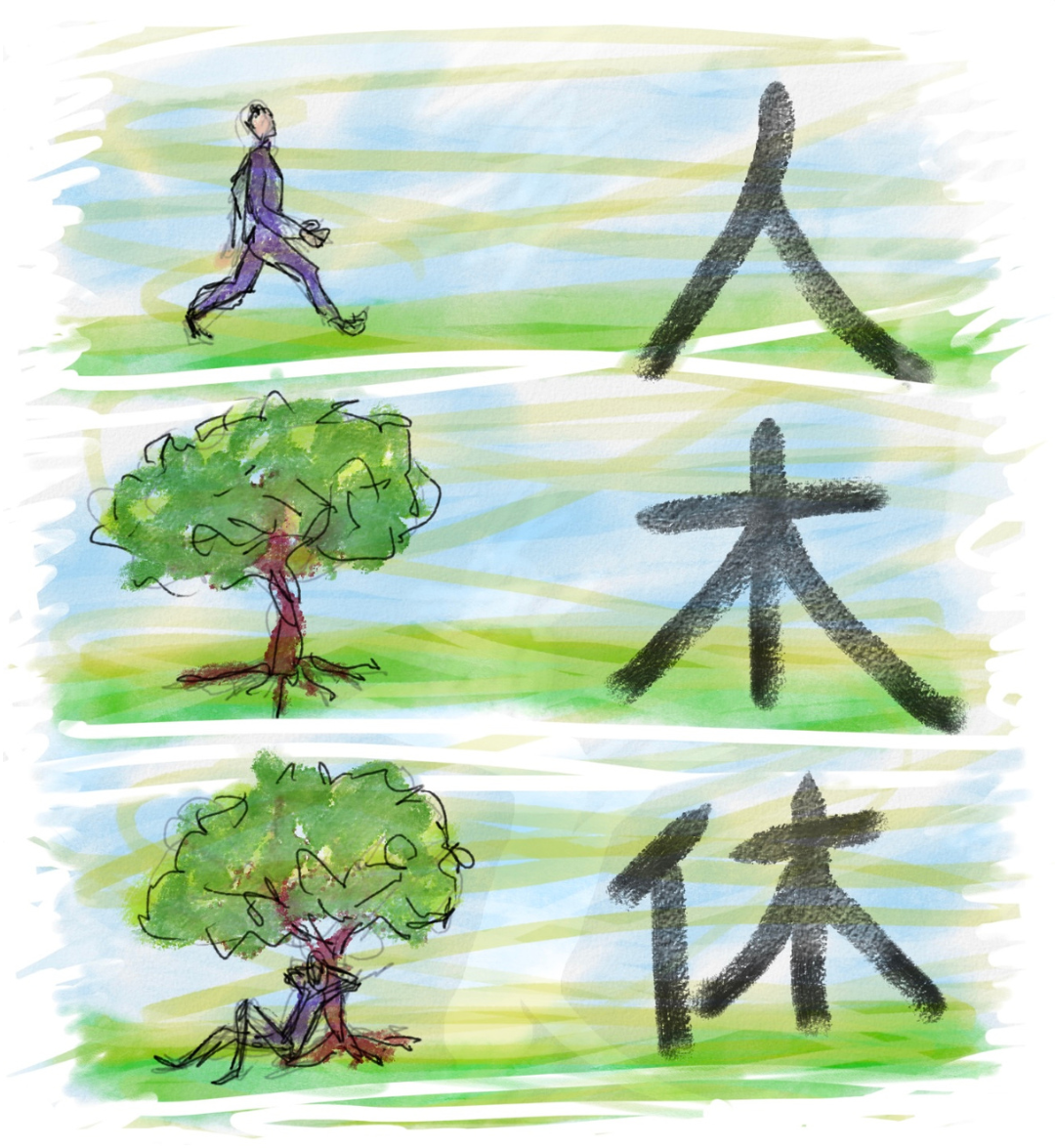
As a descendant of immigrants, I've always found the Chinese characters used in various Asian countries fascinating. When I started studying Japanese as a teenager, one of the things that most attracted me was the writing. One of the three alphabets used in the language is the Chinese ideograms, known as kanji. Even the other two alphabets are simplifications of the ideograms, but without symbolic meaning, serving only as a phonetic reading, similar to the Western alphabet.
Having enjoyed drawing since I was a child, I consider writing Chinese ideograms very similar to drawing as well. This is the reason I included today's art also as part of the Challenge: Drawing (almost) every day on iPad. Since we learned that the origin of the characters was the same elements they were meant to represent, the drawn art compares the ideograms and their meanings: person (人), tree (木), and rest (休).
Furthermore, 木 (tree) also helps explain the ideograms 林 (woods, represented by two trees) and 森 (forest, three trees). The symbols don't represent sounds (like our alphabet) but rather ideas. If we read in Okinawan (the language of my grandparents), 人 can be pronounced "tchu," 木 can be pronounced "kii," and 休 "yashinun." Just as Chinese and Japanese use them today, the same ideograms were used in Korea and Vietnam too.
Here in Brazil, a book about the Japanese brain written by neurosurgeon Dr. Raul Marino Jr., had some repercussion for arguing that reading and writing with kanji would stimulate the right side of the brain, linked to arts, feeling and aesthetics, while logical and rational reasoning (like the rules of our alphabet) would be a function of the left side.
Many thanks! Keep safe and good luck again!!
[VERSÃO EM PORTUGUÊS]

Como descendente de imigrantes sempre achei legal os caracteres chineses usados em vários países do oriente. Quando comecei a estudar japonês na adolescência uma das coisas que mais me atraia era a escrita. Um dos 3 alfabetos usados no idioma são os ideogramas chineses, conhecidos como kanji. Mesmo os outros 2 alfabetos são simplificações dos ideogramas, mas sem o sentido simbólico pois servem apenas como leitura fonética, parecido com o alfabeto ocidental.
Como gosto de desenhar desde criança, considero a escrita dos ideogramas chineses bem parecido com desenhar tb. Isso para explicar que a arte de hoje tb faz parte do Desafio: Desenhando (quase) todo dia no iPad. Como aprendemos que a origem dos caracteres eram os próprios elementos que queriam representar, o desenho compara os ideogramas e seus significados: pessoa (人), árvore (木) e descansar (休).
Aliás, 木 (árvore) tb ajuda a explicar os ideogramas 林 (bosque, representado por 2 árvores) e 森 (floresta, 3 árvores). Os símbolos não representam sons (como nosso alfabeto) e sim ideias, se formos ler em Okinawano (língua que meus avós falavam), 人 pode ser falado "tchu", 木 pode ser "kii" e 休 "yashinun". Da mesma forma como hoje o chinês e japonês utiliza, os mesmos ideogramas foram usados na Coréia e Vietnã também.
No Brasil um livro sobre o cérebro japonês escrito pelo neurocirurgião Dr. Raul Marino Jr., teve certa repercussão por defender que ler e escrever com kanji estimularia o lado direito do cérebro, ligado às artes, sentimento e estética, enquanto o raciocínio lógico e racional (como as regras do nosso abecedário) seria função do lado esquerdo.
Valeu! Saúde, sucesso e boa sorte mais uma vez!!
PS: Quem quiser acessar os posts e ilustrações já publicados e eventuais desenhos futuros do Desafio, criei a pg https://bit.ly/desenhandonoipad parte do projeto que comentei aqui em Cérebro Aberto, anotações e links compartilhados de forma aberta e colaborativa em web 3.
Posted Using INLEO